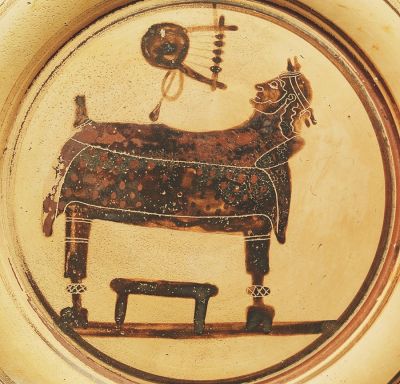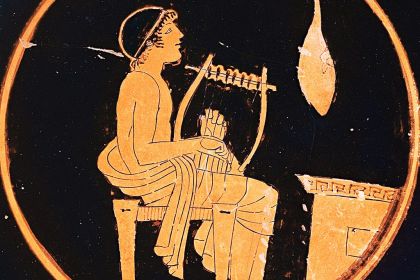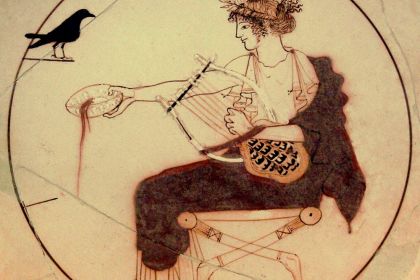Music Theory
6 songs combining harmonic minor and Aeolian mode

Terracotta Plate Attributed to the Chimaera Painter
The polyphonic structure of Western classical music distinguishes it from other musical traditions such as Indian classics where a lone melodic line is accompanied by a developed rhythm section. In contrast, polyphonic music involves the interaction between the horizontal melodic line and vertical chord structures, anticipating the listener's emotional response.
In composition, chord progressions that follow the melody are commonly built with the help of seven-note diatonic scales that also make up the corresponding musical modes traditionally named after the geographical regions of Ancient Greece: Ionian, Dorian, Phrygian, Lydian, Mixolydian, Aeolian, and Locrian.
The vast majority of compositions, whether in classical or popular music, are written in either the Ionian major mode or Aeolian mode, better known as the natural minor mode. Music theory explains that this choice ideally provides any musical piece with both a polyphonic structure and interaction of diatonic functions, the alternation of which creates tension and resolves it.
A detailed summary of the Aeolian mode, as well as song examples showing its various uses, is given in this article that also mentions one obvious disadvantage of the natural minor—its usage of the subtonic, the seventh scale degree which is a whole tone away from the first degree. In other words, the scale does not contain the leading-tone and so the Aeolian mode is devoid of the most important perfect authentic cadence.
To complement the Aeolian mode with such a vital tool as the perfect authentic cadence, songwriters usually involve the harmonic minor scale. Its only difference from the natural minor is the semitone-raised seventh degree.
C harmonic minor scale:


C harmonic minor mode contains the following triads denoted below according to the rules of harmonic analysis in which major chords are marked with uppercase Roman numerals and minor chords with lowercase Roman numerals:


Among the triads rooted in each degree of the harmonic minor scale, there are two diminished chords built on the second and seventh degrees and one augmented chord of the third degree. This fact makes the harmonic minor mode unsuitable for songwriting, but its dominant fifth-degree major chord often appears in Aeolian-mode songs to attract the leading tone.
A classic example of introducing the major dominant chord into the Aeolian mode is shown in The Doors' People Are Strange composed with the following chord progressions in the key of E minor:
- Em–Am–Em–Am–Em–B7–Em or i–iv–i–iv–i–V7–i for verses
- B7–G–B7 or V7–III–V7 for choruses
Borrowed from the harmonic minor, the B7 chord completes each line pair in the verse to form an authentic cadence with the Em tonic triad, while the chorus mostly revolves around the same B7 dominant major seventh chord:
Listen to People Are Strange by The Doors:
In a very similar way, the V7 dominant major seventh chord appears in harmonic progressions to accompany the lyrics of Spanish Caravan by The Doors, also composed in the key of E minor:
- Em–Am–B7–Em or i–iv–V7–i
- Am–Em–B7–Em or iv–i–V7–i
- Em–D–C or i–VII–VI
The instrumental sections of the song are the variations on Asturias, a flamenco-inspired work by the Spanish composer Isaac Albéniz. It is noteworthy that the ending phrase of the verses Em–D–C forms a kind of Andalusian cadence, which is the core of most flamenco genres. In its full form, the Andalusian cadence ends precisely on the dominant major chord Em–D–C–B or i–VII–VI–V.
Listen to Spanish Caravan by The Doors:
The different sections of The Beatles' I'm Only Sleeping composed in D♯ minor contain both the V7 major dominant chord (appropriated from the harmonic minor mode) and the v minor dominant triad of Aeolian mode. The A♯7 major seventh chord completes the second line of the verses, thus forming a half authentic cadence:
- D♯m–G♯m–F♯–B–F♯–A♯7 or i–iv–III–VI–III–V7
- D♯m–G♯m–F♯–B–F♯–G♯m or i–iv–III–VI–III–iv
In the chorus, the A♯m minor dominant triad appears in the middle of the harmonic progression: F♯–G♯m–A♯m–G♯m–F♯ or III–iv–v–iv–III.
Listen to I'm Only Sleeping by The Beatles:
Another example of the use of both minor and major dominant fifth-degree chords is seen in The Beatles' Girl that generally follows the key of C minor. In verse chord progressions, the G7 major dominant seventh chord appears repeatedly:
- Cm–G7–Cm–Cm7–Fm–E♭–G7 or i–V7–i–i7–iv–III–V7
- Cm–G7–Cm–Cm7–Fm–Cm or i–V7–i–i7–iv–i
It should be noted that the Cm7 tonic seventh chord is replaced by the Fm subdominant triad, fully corresponding to the classical canons in which a seventh chord resolves itself into a chord built on a note that should be a perfect fifth below the root of the seventh chord.
The chorus features the Gm minor dominant triad of the Aeolian mode: Eb–Gm–Fm–B♭7 or III–v–iv–VII7.
A curious harmonic chain appears in the bridges: Fm–C–Fm–C–Fm–C–Fm–A♭ or iv–I–iv–I–iv–I–iv–VI. Here there is a case of tonicization or the act of changing the tonal center from C minor to F minor. Marked in red to indicate it does not belong to the key of C minor, the C triad acts as a major dominant chord and resolves into the Fm temporal tonic chord.
Liste to Girl by The Beatles:
In the Scorpions' No One Like You, composed in the key of A minor, the E major dominant triad originates in the harmonic minor mode and closes all the musical phrases, thus performing a half authentic cadence:
- Am–F–G–Am–F–G–F–E or i–VI–VII–i–VI–VII–V for intro and solo
- Am–F–Am–F–Am–F–C–E or i–VI–i–VI–i–VI–III–V for verses
- Am–F–C–Am–F–C–Am–F–C–E or i–VI–III–i–VI–III–i–VI–III–V for verses
- Am–F–G–Am–F–G–Am–F–G–F–E or i–VI–VII–i–VI–VII–i–VI–VII–VI–V for first and second choruses
- Am–C–G–Am–C–G–Am–C–G–F–E or i–III–VII–i–III–VII–i–III–VII–VI–V for the third chorus
Note that apart from the Am tonic minor chord, the rest of the chords are major triads, giving the song truly positive energy.
Listen to No One Like You by Scorpions:
A good example of applying both major and minor dominant chords in the natural minor is showcased in Livin' la Vida Loca written by Draco Rosa and Desmond Child for Ricky Martin. Here are the chord progressions in the key of C♯ minor:
- C♯m–G♯–C♯m–B–C♯m or i–V–i–VII–i for verses
- C♯m–F♯m–G♯m–A–B–G♯ or i–iv–v–VI–VII–V for bridges
- C♯m–B–C♯m or i–VII–i for choruses
The bridges highlight a very energetic movement of the chords, showing a stepwise progression from the fourth to the seventh scale degrees and ending with the G♯ major dominant chord. This creates a powerful transition to the chorus which consists of just two triads, making it that much catchier.
Listen to Livin' la Vida Loca by Ricky Martin:
As mentioned before, the harmonic minor is hardly applicable on its own as its lineup contains two diminished chords and one augmented chord, as well as one interval of an augmented second between the seventh and sixth scale degrees. The theory prevents the applicability of augmented intervals in the linear voice leading due to the fact that such melodies are not viewed as extremely musical.
Discover more songs composed in Aeolian minor mode and check out their harmonic analysis in the following articles:
- 8 songs to introduce Aeolian mode and natural minor scale
- I Shot the Sheriff: Burnin' spliff nearly destroyed Bob Marley's original recording
- Mariposa Traicionera: meaning and flamenco roots of Maná's top hit
- Locomotive Breath: fine groove born from Jethro Tull's studio session
- Shaman's Blues: quintessential The Doors song refined their most controversial album
- A Dios le Pido: Juanes' Spanish lyrics behind the song success
- El Farsante and 7 more songs by Ozuna in Dorian and Aeolian modes



